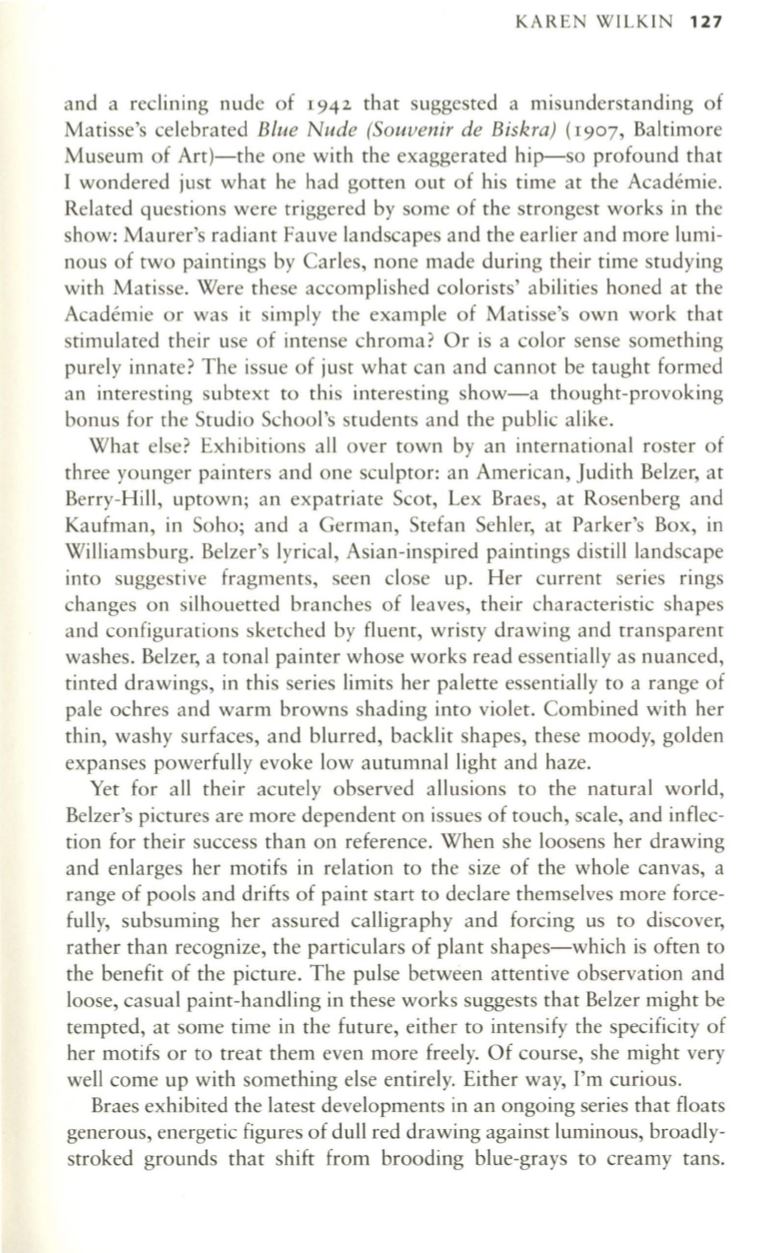
KAREN WILKIN
127
and a reclining nude of
I942
that suggested a misunderstanding of
Matisse's celebrated
Blue Nude (Souvenir de Biskra)
(I907,
Baltimore
Museum of Art)-the one with the exaggerated hip-so profound that
I wondered just what he had gotten out of his time at the Academie.
Related questions were triggered by some of the strongest works in the
show: Maurer's radiant Fauve landscapes and the earlier and more lumi–
nous of two paintings by Carles, none made during their time studying
with Matisse. Were these accomplished colorists' abilities honed at the
Academie or was it simply the example of Matisse's own work that
stimulated their use of intense chroma? Or is a color sense something
purely innate? The issue of just what can and cannot be taught formed
an interesting subtext to this interesting show-a thought-provoking
bonus for the Studio School's students and the public alike.
What else? Exhibitions all over town by an international roster of
three younger painters and one sculptor: an American, Judith Belzer, at
Berry-Hill, uptown; an expatriate Scot, Lex Braes, at Rosenberg and
Kaufman, in Soho; and a German, Stefan Sehler, at Parker's Box, in
Williamsburg. Belzer's lyrical, Asian-inspired paintings distill landscape
into suggestive fragments, seen close up. Her current series rings
changes on silhouetted branches of leaves, their characteristic shapes
and configurations sketched by fluent, wristy drawing and transparent
washes. Belzer, a tonal painter whose works read essentially as nuanced,
tinted drawings, in this series limits her palette essentially to a range of
pale ochres and warm browns shading into violet. Combined with her
thin, washy surfaces, and blurred, backlit shapes, these moody, golden
expanses powerfully evoke low autumnal light and haze.
Yet for all their acutely observed allusions
to
the natural world,
Belzer's pictures are more dependent on issues of touch, scale, and inflec–
tion for their success than on reference. When she loosens her drawing
and enlarges her motifs in relation to the size of the whole canvas, a
range of pools and drifts of paint start
to
declare themselves more force–
fully, subsuming her assured calligraphy and forcing us to discover,
rather than recognize, the particulars of plant shapes-which is often
to
the benefit of the picture. The pulse between attentive observation and
loose, casual paint-handling in these works suggests that Belzer might be
tempted, at some time in the future, either to intensify the specificity of
her motifs or
to
treat them even more freely. Of course, she might very
well come up with something else entirely. Either way, I'm curious.
Braes exhibited the latest developments in an ongoing series that floats
generous, energetic figures of dull red drawing against luminous, broadly–
stroked grounds that shift from brooding blue-grays to creamy tans.


